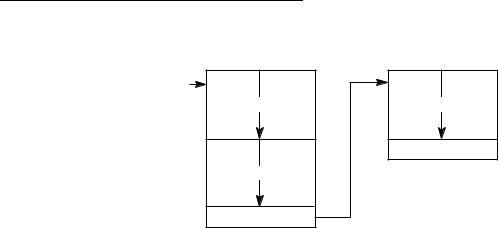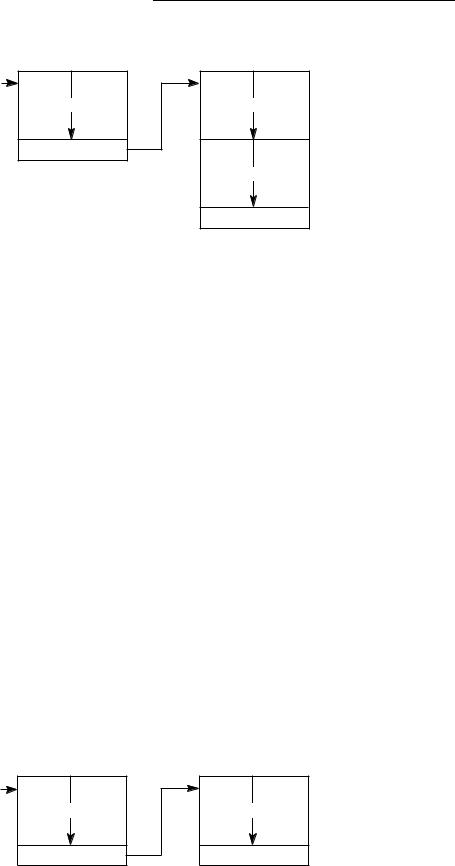
- •Table of Contents
- •List of Figures
- •List of Tables
- •1.1 Integer Unit User Programming Model
- •1.1.3 Program Counter
- •1.1.4 Condition Code Register
- •1.3 Supervisor Programming Model
- •1.3.2 Status Register
- •1.3.6 Transparent Translation/access Control Registers
- •1.4 Integer Data Formats
- •1.5 Floating-Point Data Formats
- •1.5.1 Packed Decimal Real Format
- •1.5.2 Binary Floating-Point Formats
- •1.6 Floating-Point Data Types
- •1.6.1 Normalized Numbers
- •1.6.2 Denormalized Numbers
- •1.6.3 Zeros
- •1.6.4 Infinities
- •1.6.5 Not-A-Numbers
- •1.6.6 Data Format and Type Summary
- •1.7 Organization of Data in Registers
- •1.7.1 Organization of Integer Data Formats in Registers
- •1.7.2 Organization of Integer Data Formats in Memory
- •1.7.4 Organization of Fpu Data Formats in Registers and Memory
- •2.1 Instruction Format
- •2.2 Effective Addressing Modes
- •2.2.1 Data Register Direct Mode
- •2.2.2 Address Register Direct Mode
- •2.2.3 Address Register Indirect Mode
- •2.2.4 Address Register Indirect with Postincrement Mode
- •2.2.5 Address Register Indirect with Predecrement Mode
- •2.2.6 Address Register Indirect with Displacement Mode
- •2.2.9 Memory Indirect Postindexed Mode
- •2.2.10 Memory Indirect Preindexed Mode
- •2.2.11 Program Counter Indirect with Displacement Mode
- •2.2.14 Program Counter Memory Indirect Postindexed Mode
- •2.2.15 Program Counter Memory Indirect Preindexed Mode
- •2.2.16 Absolute Short Addressing Mode
- •2.2.17 Absolute Long Addressing Mode
- •2.2.18 Immediate Data
- •2.3 Effective Addressing Mode Summary
- •2.4 Brief Extension Word Format Compatibility
- •2.5.1 No Memory Indirect Action Mode
- •2.5.2 Memory Indirect Modes
- •2.6.1 Other Data Structures
- •2.6.1 System Stack
- •2.6.2 Queues
- •3.1 Instruction Summary
- •3.1.1 Data Movement Instructions
- •3.1.2 Integer Arithmetic Instructions
- •3.1.3 Logical Instructions
- •3.1.4 Shift and Rotate Instructions
- •3.1.5 Bit Manipulation Instructions
- •3.1.6 Bit Field Instructions
- •3.1.7 Binary-Coded Decimal Instructions
- •3.1.8 Program Control Instructions
- •3.1.9 System Control Instructions
- •3.1.11 Multiprocessor Instructions
- •3.1.13 Floating-Point Arithmetic Instructions
- •3.2 Integer Unit Condition Code Computation
- •3.3 Instruction Examples
- •3.3.2 Using the Moves Instruction
- •3.3.3 Nested Subroutine Calls
- •3.3.4 Bit Field Instructions
- •3.3.5 Pipeline Synchronization with the Nop Instruction
- •3.4 Floating-Point Instruction Details
- •3.5 Floating-Point Computational Accuracy
- •3.5.1 Intermediate Result
- •3.5.2 Rounding the Result
- •3.6 Floating-Point Postprocessing
- •3.7 Instruction Descriptions
- •8.1 Instruction Format
- •8.1.1 Coprocessor ID Field
- •8.1.2 Effective Address Field
- •8.1.4 Source Specifier Field
- •8.1.5 Destination Register Field
- •8.1.6 Conditional Predicate Field
- •8.1.7 Shift and Rotate Instructions
- •8.1.8 Size Field
- •8.1.9 Opmode Field
- •8.1.10 Address/Data Field
- •8.2 Operation Code Map
- •A.1 MC68000, MC68008, MC68010 Processors
- •A.1.2 MC68000, MC68008, and MC68010 Addressing Modes
- •A.2 MC68020 Processors
- •A.2.1 MC68020 Instruction Set
- •A.2.2 MC68020 Addressing Modes
- •A.3 MC68030 Processors
- •A.3.1 MC68030 Instruction Set
- •A.3.2 MC68030 Addressing Modes
- •A.4 MC68040 Processors
- •A.4.1 MC68040 Instruction Set
- •A.4.2 MC68040 Addressing Modes
- •A.5 MC68881/MC68882 CoProcessors
- •A.5.2 MC68881/MC68882 Addressing Modes
- •A.6 MC68851 Coprocessors
- •A.6.1 MC68851 Instruction Set
- •A.6.2 MC68851 Addressing Modes
- •B.1 Exception Vector Assignments for the M68000 Family
- •B.2 Exception Stack Frames
- •B.3 Floating-Point Stack Frames
- •C.1 S-Record Content
- •C.2 S-Record Types
- •C.3 S-Record Creation

Addressing Capabilities
2.5.1 No Memory Indirect Action Mode
No memory indirect action mode uses BR, Xn with its modifiers, and bd to calculate the address of the required operand. Data register indirect (Dn) and absolute address with index
(bd,Xn.SIZE*SCALE) are examples of the no memory indirect action mode. Figure 2-5 illustrates the no memory indirect action mode.
BR |
Xn |
bd |
Addressing Mode |
|
|
|
|
S |
S |
S |
Not Applicable |
|
|
|
|
S |
S |
A |
Absolute Addressing Mode |
|
|
|
|
S |
A |
S |
Register Indirect |
|
|
|
|
S |
A |
A |
Register Indirect with Constant Index |
|
|
|
|
An |
S |
S |
Address Register Indirect |
|
|
|
|
An |
S |
A |
Address Register Indirect with Constant Index |
|
|
|
|
An |
A |
S |
Address Register Indirect with Variable Index |
|
|
|
|
An |
A |
A |
Address Register Indirect with Constant and Variable Index |
|
|
|
|
PC |
S |
S |
PC Relative |
|
|
|
|
PC |
S |
A |
PC Relative with Constant Index |
|
|
|
|
PC |
A |
S |
PC Relative with Variable Index |
|
|
|
|
PC |
A |
A |
PC Relative with Constant and Variable Index |
|
|
|
|
NOTE: S indicates suppressed and A indicates active.
.
An or PC
bd.BD SIZE
Xn.SIZE*SCALE
OPERAND
Figure 2-5. No Memory Indirect Action
2-24 |
M68000 FAMILY PROGRAMMER’S REFERENCE MANUAL |
MOTOROLA |

Addressing Capabilities
2.5.2 Memory Indirect Modes
Memory indirect modes fetch two operands from memory. The BR and bd evaluate the address of the first operand, intermediate memory pointer (IMP). The value of IMP and the od evaluates the address of the second operand.
There are three types of memory indirect modes: pre-index, post-index, and index register suppressed. Xn and its modifiers can be allocated to determine either the address of the IMP
(pre-index) or to the address of the second operand (post-index).
2.5.2.1 MEMORY INDIRECT WITH PREINDEX. The Xn is allocated to determine the address of the IMP. Figure 2-6 illustrates the memory indirect with pre-indexing mode.
BR |
Xn |
bd |
od |
IMP Addressing Mode |
Operand Addressing Mode |
|
|
|
|
|
|
|
|
S |
A |
S |
S |
Register Indirect |
Memory Pointer Directly to Data Operand |
|
|
|
|
|
|
|
|
S |
A |
S |
A |
Register Indirect |
Memory Pointer as Base with Displacement |
|
to Data Operand |
||||||
|
|
|
|
|
||
|
|
|
|
|
|
|
S |
A |
A |
S |
Register Indirect with Constant Index |
Memory Pointer Directly to Data Operand |
|
|
|
|
|
|
|
|
S |
A |
A |
A |
Register Indirect with Constant Index |
Memory Pointer as Base with Displacement |
|
to Data Operand |
||||||
|
|
|
|
|
||
|
|
|
|
|
|
|
An |
A |
S |
S |
Address Register Indirect with |
Memory Pointer Directly to Data Operand |
|
Variable Index |
||||||
|
|
|
|
|
||
|
|
|
|
|
|
|
An |
A |
S |
A |
Address Register Indirect with |
Memory Pointer as Base with Displacement |
|
Variable Index |
to Data Operand |
|||||
|
|
|
|
|||
|
|
|
|
|
|
|
An |
A |
A |
S |
Address Register Indirect with |
Memory Pointer Directly to Data Operand |
|
Constant and Variable Index |
||||||
|
|
|
|
|
||
|
|
|
|
|
|
|
An |
A |
A |
A |
Address Register Indirect with |
Memory Pointer as Base with Displacement |
|
Constant and Variable Index |
to Data Operand |
|||||
|
|
|
|
|||
|
|
|
|
|
|
|
PC |
A |
S |
S |
PC Relative with Variable Index |
Memory Pointer Directly to Data Operand |
|
|
|
|
|
|
|
|
PC |
A |
S |
A |
PC Relative with Variable Index |
Memory Pointer as Base with Displacement |
|
to Data Operand |
||||||
|
|
|
|
|
||
|
|
|
|
|
|
|
PC |
A |
A |
S |
PC Relative with Constant and |
Memory Pointer Directly to Data Operand |
|
Variable Index |
||||||
|
|
|
|
|
||
|
|
|
|
|
|
|
PC |
A |
A |
A |
PC Relative with Constant and |
Memory Pointer as Base with Displacement |
|
Variable Index |
to Data Operand |
|||||
|
|
|
|
|||
|
|
|
|
|
|
NOTE: S indicates suppressed and A indicates active.
MOTOROLA |
M68000 FAMILY PROGRAMMER’S REFERENCE MANUAL |
2-25 |

Addressing Capabilities
.
An or PC
bd.BD SIZE |
od.OD SIZE |
OPERAND
Xn.SIZE*SCALE
IMP
Figure 2-6. Memory Indirect with Preindex
2.5.2.2 MEMORY INDIRECT WITH POSTINDEX. The Xn is allocated to evaluate the address of the second operand. Figure 2-7 illustrates the memory indirect with post-indexing mode.
BR |
Xn |
bd |
od |
IMP Addressing Mode |
Operand Addressing Mode |
|
|
|
|
|
|
|
|
S |
A |
S |
S |
— |
— |
|
|
|
|
|
|
|
|
S |
A |
S |
A |
— |
— |
|
|
|
|
|
|
|
|
S |
A |
A |
S |
Absolute Addressing Mode |
Memory Pointer with Variable Index to |
|
Data Operand |
||||||
|
|
|
|
|
||
|
|
|
|
|
|
|
S |
A |
A |
A |
Absolute Addressing Mode |
Memory Pointer with Constant and Variable |
|
Index to Data Operand |
||||||
|
|
|
|
|
||
|
|
|
|
|
|
|
An |
A |
S |
S |
Address Register Indirect |
Memory Pointer with Variable Index to |
|
Data Operand |
||||||
|
|
|
|
|
||
|
|
|
|
|
|
|
An |
A |
S |
A |
Address Register Indirect |
Memory Pointer with Constant and Variable |
|
Index to Data Operand |
||||||
|
|
|
|
|
||
|
|
|
|
|
|
|
An |
A |
A |
S |
Address Register Indirect with |
Memory Pointer with Variable Index to |
|
Constant Index |
Data Operand |
|||||
|
|
|
|
|||
|
|
|
|
|
|
|
An |
A |
A |
A |
Address Register Indirect with |
Memory Pointer with Constant and Variable |
|
Constant Index |
Index to Data Operand |
|||||
|
|
|
|
|||
|
|
|
|
|
|
|
PC |
A |
S |
S |
PC Relative |
Memory Pointer with Variable Index to |
|
Data Operand |
||||||
|
|
|
|
|
||
|
|
|
|
|
|
|
PC |
A |
S |
A |
PC Relative |
Memory Pointer with Constant and Variable |
|
Index to Data Operand |
||||||
|
|
|
|
|
||
|
|
|
|
|
|
|
PC |
A |
A |
S |
PC Relative with Constant Index |
Memory Pointer with Variable Index to |
|
Data Operand |
||||||
|
|
|
|
|
||
|
|
|
|
|
|
|
PC |
A |
A |
A |
PC Relative with Constant Index |
Memory Pointer with Constant and Variable |
|
Index to Data Operand |
||||||
|
|
|
|
|
||
|
|
|
|
|
|
NOTE: S indicates suppressed and A indicates active.
2-26 |
M68000 FAMILY PROGRAMMER’S REFERENCE MANUAL |
MOTOROLA |

Addressing Capabilities
.
An or PC
bd.BD SIZE |
od.OD SIZE |
IMP
od.OD SIZE
OPERAND
Figure 2-7. Memory Indirect with Postindex
2.5.2.3 MEMORY INDIRECT WITH INDEX SUPPRESSED. The Xn is suppressed. Figure
2-8 illustrates the memory indirect with index suppressed mode.
BR |
Xn |
bd |
od |
IMP Addressing Mode |
Operand Addressing Mode |
|
|
|
|
|
|
|
|
S |
S |
S |
S |
— |
— |
|
|
|
|
|
|
|
|
S |
S |
S |
A |
— |
— |
|
|
|
|
|
|
|
|
S |
S |
A |
S |
Absolute Addressing Mode |
Memory Pointer Directly to Data Operand |
|
|
|
|
|
|
|
|
S |
S |
A |
A |
Absolute Addressing Mode |
Memory Pointer as Base with Displacement |
|
to Data Operand |
||||||
|
|
|
|
|
||
|
|
|
|
|
|
|
An |
S |
S |
S |
Address Register Indirect |
Memory Pointer Directly to Data Operand |
|
|
|
|
|
|
|
|
An |
S |
S |
A |
Address Register Indirect |
Memory Pointer as Base with Displacement |
|
to Data Operand |
||||||
|
|
|
|
|
||
|
|
|
|
|
|
|
An |
S |
A |
S |
Address Register Indirect with |
Memory Pointer Directly to Data Operand |
|
Constant Index |
||||||
|
|
|
|
|
||
|
|
|
|
|
|
|
An |
S |
A |
A |
Address Register Indirect with |
Memory Pointer as Base with Displacement |
|
Constant Index |
to Data Operand |
|||||
|
|
|
|
|||
|
|
|
|
|
|
|
PC |
S |
S |
S |
PC Relative |
Memory Pointer Directly to Data Operand |
|
|
|
|
|
|
|
|
PC |
S |
S |
A |
PC Relative |
Memory Pointer as Base with Displacement |
|
to Data Operand |
||||||
|
|
|
|
|
||
|
|
|
|
|
|
|
PC |
S |
A |
S |
PC Relative with Constant Index |
Memory Pointer Directly to Data Operand |
|
|
|
|
|
|
|
|
PC |
S |
A |
A |
PC Relative with Constant Index |
Memory Pointer as Base with Displacement |
|
to Data Operand |
||||||
|
|
|
|
|
||
|
|
|
|
|
|
NOTE: S indicates suppressed and A indicates active.
.
An or PC
bd.BD SIZE |
od.OD SIZE |
IMP |
OPERAND |
Figure 2-8. Memory Indirect with Index Suppress
MOTOROLA |
M68000 FAMILY PROGRAMMER’S REFERENCE MANUAL |
2-27 |
